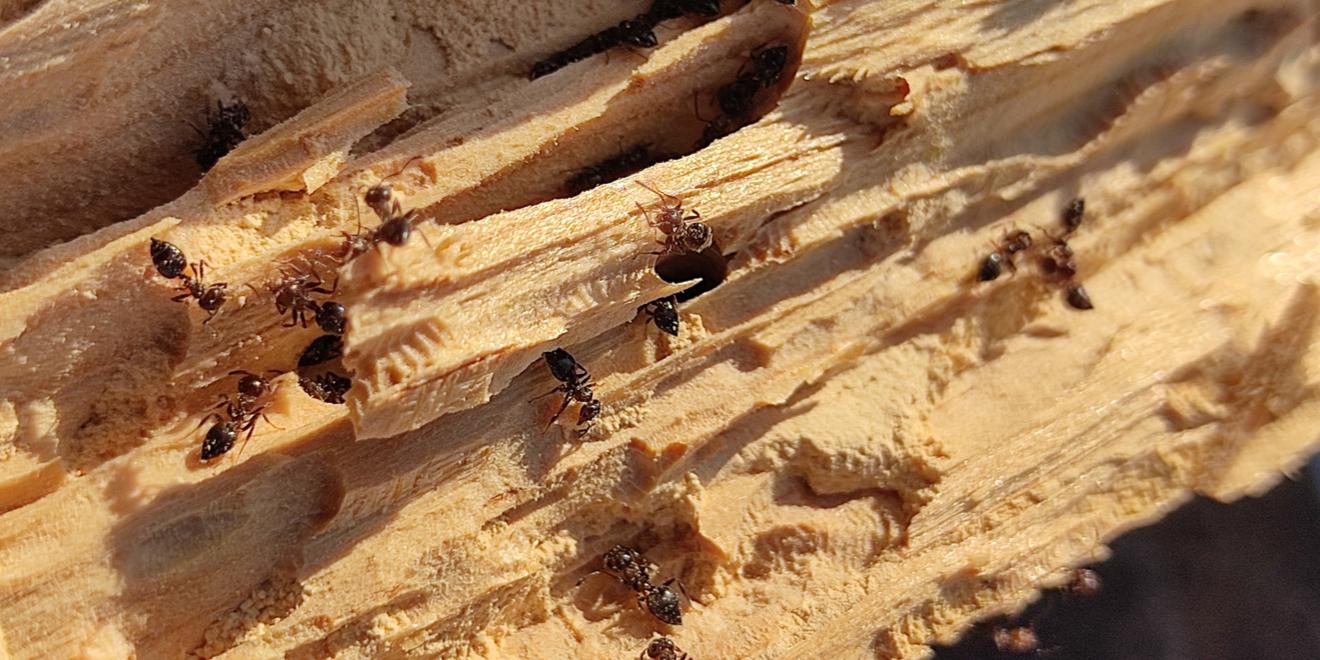The Wood-Chewing Menace: Identify and Get Rid of Carpenter Ants
Posted by Mosquito Squad
November 26, 2025

Carpenter ants are common and destructive household invaders. Unlike termites, carpenter ants don’t eat wood. They use powerful jaws to carve out smooth, intricate tunnels that house their colonies. Over time, this hollowing weakens beams, decks, and even the structural frame of your home. Think of them as tiny demolition crews: quiet, tireless, and hidden in the shadows.
Understanding where carpenter ants come from and how to identify carpenter ants is the first step to getting rid of them and keeping them out!
What Do Carpenter Ants Look Like?
Carpenter ants are a larger type of ant and can grow to over ½ an inch long. They have six legs, bent antennae, narrow bodies, and are usually jet black or reddish brown-colored. Carpenter ants have strong mandibles that allow them to hollow out wood, leaving piles of sawdust-like debris.
While most carpenter ants don’t have wings, you may see carpenter ants with wings in the spring when reproductive ants, also known as swarmers, leave their colonies to mate and create new colonies
Where Do Carpenter Ants Come From?
Most colonies start outside where they live in decaying trees, stumps, or firewood piles. From there, carpenter ants move indoors through cracks, gaps, or even branches that touch the side of your home. They may also form their nest near leaky pipes, in window frames, or in other areas around your home that are water damaged. Once inside, they establish satellite nests in damp wall voids, under shingles, inside insultation, or any other area that is soft, damp, and easy for ants to excavate.
Signs of Carpenter Ants in Your House
Keep an eye out for these common red flags that may indicate a carpet ant infestation:
- Frass: Piles of wood shavings and insect parts near baseboards or windows.
- Unusual noises: Rustling or crunching sounds inside walls.
- Carpenter ant damage: Wood that sounds hollow when tapped.
- Active ants: Swarms of winged carpenter ants inside your home during springtime, other times of the year you are most likely to see them foraging for food when they are active at night.
If you notice any of these signs of carpenter ants in your house, it’s time to act.
What Do Carpenter Ants Eat?
While carpenter ants carve out their homes in wood, they don’t eat the wood. Their menu includes proteins and sweets such as dead insects, pet food, honeydew from aphids, or stray crumbs left behind. That’s why carpenter ants are often found trailing across countertops and kitchen floors at night. If you have open containers of food or other pest problems on your hands, don’t be surprised if carpenter ants notice and are drawn to your space.
Do Carpenter Ants Bite?
Yes, carpenter ants can bite. Although carpenter ants are less aggressive than some other types of ants that bite, like fire ants, when threatened they can bite with noticeable force. They may also spray formic acid into the wound when they clamp down. This carpenter ant spray acts as a defense mechanism that causes a burning sensation. A carpenter ant bite can sting, but it’s usually not dangerous or life-threatening unless an allergic reaction occurs. If swelling or other reaction symptoms persist, contact a medical professional.
How To Get Rid of Carpenter Ants
When carpenter ants move in, swift action is key for effective infestation management. To get rid of existing populations inside, place carpenter ant bait near trails or known nests. You can also create homemade bait using one-part boric acid or baking soda mixed with two parts powdered sugar and place it near them. If you spot ants outside, call Mosquito Squad® pros to spray trees with carpenter ants. Our professionals will target visible carpenter ants and places where they may secretly hide and thrive throughout your property.
How to Prevent Carpenter Ants
Once you’ve gotten rid of carpenter ants, keep them away with these defensive tactics:
- Store firewood away from your home.
- Remove decaying wood from your property.
- Trim back branches touching your home.
- Fix leaks and improve ventilation, especially in humidity-prone areas.
- Keep food, including pet food, in sealed containers.
- Seal cracks and openings around foundations and siding.
- Keep gutters clean to reduce dampness.
- Have your local Squad spray a perimeter treatment around your home and yard.
- Get rid of scent trails that may attract future ants using a spray of equal parts white vinegar and water near old nests.
Call the Squad for Professional Support
Don’t let carpenter ants turn your house into their lumberyard. Professional services from Mosquito Squad® Plus identify infestations outside, apply targeted treatments, and help protect your property year-round. Barrier treatment sprays kill pests, including carpenter ants, on contract, then continue to deter them for up to 21 days.
Call (877) 332-2239 today or request a cost-free quote online to learn more about local carpenter ant control.
